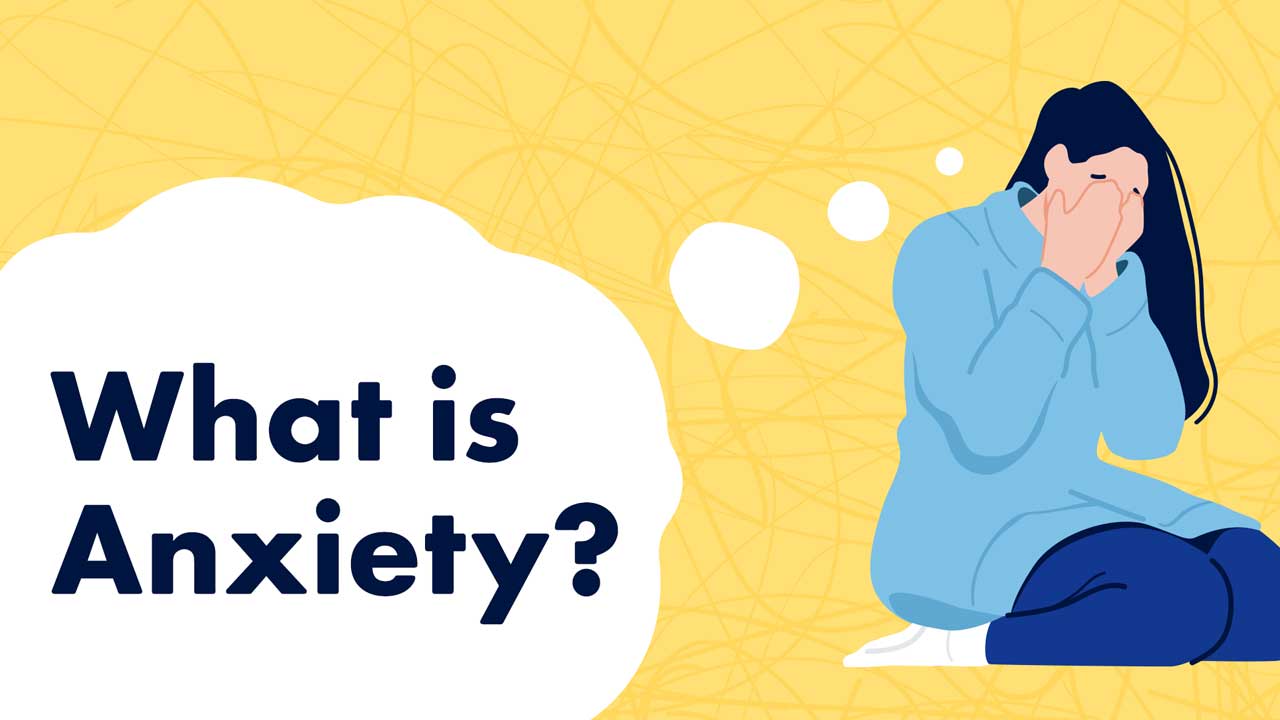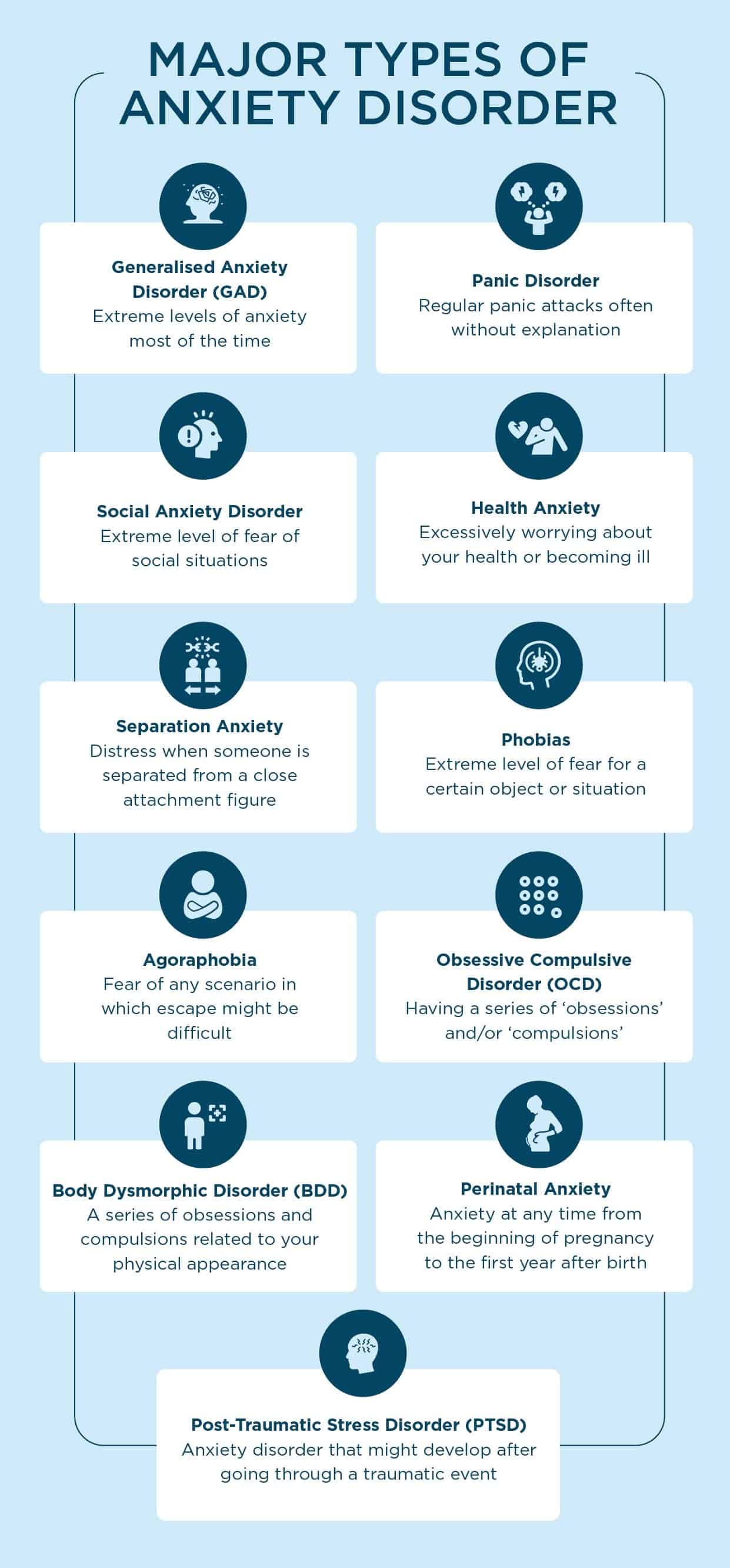Last updated on May 6th, 2024 at 02:48 pm
Anxiety disorders are pervasive mental health conditions that affect millions of individuals worldwide. They go beyond the ordinary stress or nervousness we all experience from time to time, evolving into chronic and debilitating conditions. In this comprehensive blog article, we will delve into the various types of anxiety disorders, shedding light on their distinct characteristics, symptoms, and impact on daily life.

Understanding Anxiety Disorders:
Anxiety disorders represent a diverse group of mental health conditions characterized by intense and prolonged feelings of fear, worry, or apprehension. Unlike the typical, fleeting moments of anxiety we all experience, anxiety disorders manifest in a more severe and persistent manner, significantly impacting an individual’s ability to function in various aspects of life.
Anxiety disorders are complex mental health conditions that transcend the ordinary fluctuations of stress and worry. They form a diverse group of disorders, each with its unique manifestations, but collectively, they share a common thread of overwhelming fear, anxiety, and unease. Unlike the transient bouts of anxiety experienced in response to specific stressors, anxiety disorders are characterized by persistent and often debilitating feelings that extend far beyond the norm.
In essence, anxiety disorders can be seen as an intricate tapestry of psychological and physiological responses. The emotional component involves an intense and prolonged experience of fear or worry, often disproportionate to the actual threat. This emotional turmoil is not easily dismissed and can infiltrate various aspects of an individual’s life, affecting relationships, work, and overall well-being.
The physiological aspect of anxiety disorders adds another layer of complexity. The body responds to perceived threats with a cascade of changes, triggering the well-known “fight-or-flight” response. However, in anxiety disorders, this response is not reserved for genuine dangers but can be activated in seemingly mundane situations. The result is a range of physical symptoms, from increased heart rate and shallow breathing to muscle tension and gastrointestinal discomfort.
The impact of anxiety disorders extends beyond the individual experiencing them. Friends, family members, and colleagues may witness the challenges faced by someone grappling with anxiety. Relationships can be strained, and the ability to navigate day-to-day activities can be compromised. Understanding anxiety disorders requires a holistic perspective—one that recognizes the interplay of emotional, cognitive, and physiological factors.
Moreover, the distinction between normal anxiety and an anxiety disorder lies in the persistence and intensity of symptoms. While everyone encounters stress and anxiety, those with anxiety disorders find themselves caught in a seemingly unending cycle of worry and fear. These conditions are not fleeting; they are enduring and often require targeted interventions to break the cycle.
In exploring the landscape of the types of anxiety disorders, we embark on a journey to comprehend the intricate workings of the human mind and body under the influence of pervasive anxiety. From genetic predispositions to environmental triggers, the causes are multifaceted. Anxiety disorders are not a sign of weakness or a lack of resilience; rather, they are complex conditions deserving of empathy, understanding, and effective treatment strategies. This understanding serves as a foundation for delving into the specific types of anxiety disorders, each with its nuances and impact on those who experience them.
Causes of Anxiety Disorders:
:max_bytes(150000):strip_icc()/gad-causes-risk-factors-1392982-488cca43a0484ff7804288f6129035f9.png)
- Genetic Factors: Genetic predisposition plays a significant role in the development of anxiety disorders. If there’s a family history of anxiety disorders, individuals may inherit a genetic susceptibility, making them more prone to experiencing heightened anxiety levels.
- Brain Chemistry: Neurotransmitters, the brain’s chemical messengers, contribute to regulating mood and anxiety levels. Imbalances in neurotransmitters, such as serotonin and dopamine, can disrupt these regulatory mechanisms, leading to the onset of anxiety disorders.
- Environmental Factors: Traumatic life events, chronic stress, and a history of abuse can create an environment conducive to anxiety disorders. Prolonged exposure to stressors can reshape the brain’s response to stress, making individuals more susceptible to anxiety-related challenges.
- Personality and Temperament: Certain personality traits, like a predisposition to anxious thoughts or a natural tendency to avoid risks, can contribute to the development of anxiety disorders. Understanding these traits is crucial in tailoring effective therapeutic interventions.
- Medical Conditions: Underlying medical conditions, such as thyroid disorders or chronic illnesses, may manifest with anxiety symptoms. Addressing these medical issues is essential in managing anxiety effectively, as their resolution can alleviate or mitigate anxiety-related challenges.
- Substance Abuse: Substance abuse, including the misuse of drugs or alcohol, can exacerbate or trigger anxiety disorders. Additionally, withdrawal from substances can induce heightened anxiety, complicating both the treatment and management of anxiety-related conditions.
Types of Anxiety Disorders:

1. Generalized Anxiety Disorder (GAD):
Generalized Anxiety Disorder (GAD) is a persistent and overwhelming state of worry that extends far beyond the usual stressors of daily life. Individuals grappling with GAD experience excessive anxiety about a wide array of issues, ranging from personal relationships and work responsibilities to health concerns and financial matters.
GAD manifests not only in the mind but also in the body. Physical symptoms like muscle tension, headaches, and fatigue accompany the constant mental turmoil. Understanding that GAD is more than occasional stress is crucial. Imagine feeling as if a dark cloud constantly looms overhead, impacting decision-making, sleep patterns, and overall quality of life. By detailing the physical and mental toll of GAD, readers can better empathize with those facing this disorder.
2. Social Anxiety Disorder (SAD):
Social Anxiety Disorder, often underestimated as mere shyness, is an intense fear of social situations where individuals fear judgment, criticism, or embarrassment. This fear can be so crippling that individuals go to great lengths to avoid social interactions, limiting both personal and professional growth.
To truly comprehend the challenges of SAD, consider the anxiety-inducing scenarios many take for granted, such as public speaking, meeting new people, or attending social events. Detailing the physical symptoms—racing heart, trembling, sweating—offers a glimpse into the profound impact of social anxiety on one’s daily life. By making these experiences relatable, readers can gain a deeper understanding of the struggles faced by those with Social Anxiety Disorder.
3. Panic Disorder:
Panic Disorder is characterized by recurrent, unexpected panic attacks—sudden bursts of intense fear with physical symptoms like a racing heart, shortness of breath, chest pain, and an overwhelming sense of impending doom. These attacks can be debilitating, striking at any moment and causing significant distress.
Understanding the physiological aspect of panic attacks involves recognizing the role of the fight-or-flight response. The body’s instinctual reaction to perceived threats can lead to a cascade of symptoms that intensify the overall experience. The impact on daily life is far-reaching, as individuals live in constant fear of the next attack. This chronic apprehension can disrupt relationships, careers, and overall well-being, emphasizing the urgent need for professional intervention.
4. Obsessive-Compulsive Disorder (OCD):
Obsessive-Compulsive Disorder is characterized by intrusive, unwanted thoughts (obsessions) and repetitive behaviors or mental acts (compulsions) performed to alleviate anxiety. The obsessions can range from contamination fears to fears of causing harm, while compulsions often manifest as rituals seeking symmetry or order.
Exploring specific examples, such as an individual compelled to wash their hands for hours due to contamination fears, illustrates the distressing nature of OCD. The impact on daily life is profound, as these rituals consume significant time and energy. The diversity of obsessive themes highlights the complexity of the disorder, with each person’s experience unique. Recognizing the interference of OCD in relationships, work, and overall quality of life is crucial for fostering empathy and understanding.
5. Post-Traumatic Stress Disorder (PTSD):
Post-Traumatic Stress Disorder (PTSD) develops after exposure to a traumatic event, leading to intrusive memories, flashbacks, nightmares, and emotional distress. Traumatic events can range from combat experiences to natural disasters or interpersonal violence.
Understanding the triggers for PTSD involves recognizing the various types of traumatic events and their lasting impact. Neurobiological changes associated with trauma and the body’s stress response system play a role in the development of PTSD. The profound effect on daily life, relationships, and mental well-being underscores the importance of tailored therapeutic approaches to address the specific needs of individuals with PTSD.
6. Specific Phobias:
Specific Phobias involve an intense and irrational fear of a particular object, situation, or activity, leading to avoidance behaviors. Common examples include fear of flying, heights, spiders, or enclosed spaces.
To delve into the details, imagine the paralyzing fear an individual with a specific phobia experiences when confronted with their trigger. This fear is not a rational response but an overwhelming and uncontrollable reaction. The impact on daily life is considerable, as individuals may rearrange their routines or avoid certain places altogether to steer clear of their phobia. Exploring the origins of specific phobias and the mechanisms behind avoidance behaviors enhances our understanding of these anxiety disorders.
7. Separation Anxiety Disorder:
Separation Anxiety Disorder goes beyond the typical discomfort associated with being apart from loved ones. It involves excessive fear and anxiety about separation, leading to significant distress when anticipating or experiencing separation.
Detailing the impact involves delving into the emotional turmoil experienced by individuals with separation anxiety. The fear of separation often leads to behaviors like refusing to leave home or being overly clingy, even in adulthood. Recognizing the impact on relationships, work, and overall independence is essential for comprehending the challenges faced by those with separation anxiety.
8. Agoraphobia:
Agoraphobia involves an intense fear of situations or places where escape might be difficult or embarrassing, leading to avoidance of these spaces. Common triggers include crowded places, public transportation, or being outside the home alone.
To understand the intricacies of agoraphobia, envision the paralyzing fear that arises when faced with the prospect of being in a situation perceived as unsafe. This fear can result in individuals isolating themselves to avoid potential triggers. The impact on daily life is substantial, affecting everything from social interactions to the ability to perform routine tasks outside the comfort of one’s home. Exploring the nuances of agoraphobia sheds light on the challenges faced by those navigating this anxiety disorder.
Conclusion:
In conclusion, anxiety disorders encompass a diverse range of conditions, each with its unique characteristics and impact on daily life. Through detailed exploration, we’ve uncovered the intricacies of Generalized Anxiety Disorder, Social Anxiety Disorder, Panic Disorder, Obsessive-Compulsive Disorder, Post-Traumatic Stress Disorder, Specific Phobias, Separation Anxiety Disorder, and Agoraphobia. Recognizing the depth of these disorders fosters empathy and understanding, crucial components in promoting mental health awareness and support for those facing these challenges.

